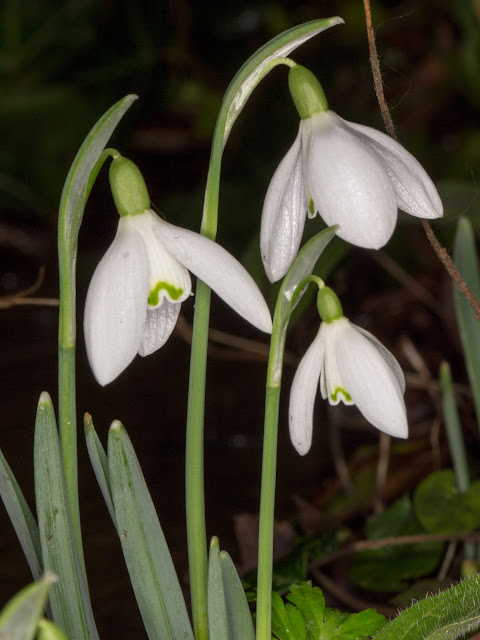 |
| Snowdrops, Galanthus nivalis, in my back garden in Hayes. |
Wednesday, 30 January 2013
Snowdrops
Saturday, 26 January 2013
The Velvet Shank
 |
| Velvet Shank, Flammulina velutipes, in snow on a tree stump in Hayes. 24 January 2013. |
Behind the caps and gills ypou can see what gives it its common name. The dark brown, slightly reddish stipe is covered with velvety hairs.
Tuesday, 22 January 2013
Tree Slugs
 |
| A group of Tree Slugs, Lehmannia marginata. Hayes Common, 1 January 2013. |
These slugs live on lichens, algae and fungi, all of which they can easily find on the trees where they live. But I don't know why half a dozen of them should have been making their way downwards in a group.
They are quite well disguised, but they glisten, which drew my attention.
Saturday, 12 January 2013
Fungus on Holm Oak
 |
| A concentric fungus infection on Holm Oak (Quercus ilex). High Elms, 29 December 2012. Reflected light. |
 |
| A concentric fungus infection on Holm Oak (Quercus ilex). High Elms, 29 December 2012. Transmitted light. |
I don't know what fungus caused this, but it was too interesting to ignore.
Holm Oaks are our only evergreen oaks. They are not native to the UK, but are naturalised and well established. Only the saplings have spiky leaves like this, which protect them from grazing. Leaves on mature trees have a single point at the end.
Tuesday, 8 January 2013
High Elms Fungi, December 2012
 |
| Panellus stipticus (Bitter Oysterling). High Elms, 29 December 2012. |
The Bitter Oysterling is indeed bitter to the taste, I have been assured by someone who has tried it. It is also supposed to be able to stop the flow of blood from a cut, hence the name "stipticus" - but I don't know anyone who has tested that. The scurfy appearance of the caps makes this one easy to spot.
 |
| Auricularia auricula-judae (Jelly Ear). High Elms, 29 December 2012. |
 |
| Hypoxylon multiforme (Birch Woodwart). High Elms, 29 December 2012. |
 |
| Ascocoryne sarcoides (Purple Jellydisc). High Elms, 29 December 2012. |
There seems to be another flush of fungi at the moment; not so much on the ground, but lots on dead wood. The warm and exceptionally wet weather probably accounts for that. The ground is too wet, but dead trees are just right.
Friday, 4 January 2013
Common Cordgrass
 |
| Common Cordgrass, Spartina anglica. Riverside Country Park, 10 August 2012. |
Common Cordgrass is a new species, resulting from cross-pollination of two related species. One parent, Spartina maritima, is native to the UK, and the other, Spartina alterniflora, was introduced from America. Most hybrids are sterile, but some plants can overcome this by multiplying their chromosomes. That happened quite naturally in this case, and it is now able to reproduce itself. This species did not exist before the late 19th century. I find that remarkable.
 |
| Common Cordgrass, Spartina anglica. Riverside Country Park, 10 August 2012. The inset shows the stipule. |
Tuesday, 1 January 2013
Pratt's Bottom
 |
| Greater Periwinkle, Vinca major. Pratt's Bottom. 1 December 2012. |
It was a frosty morning. This Periwinkle is a common garden plant, great for ground cover in shaded areas, and this one was in a hedgerow opposite houses. The frosted edges look delightful.
 |
| Viburnum tinus, Laurustinus. Pratt's Bottom. 1 December 2012. |
 |
| Coprinellus micaceus (Glistening Inkcap). In the woods by Pratt's Bottom, 1 December 2012. |
 |
| Phellinus species. In the woods by Pratt's Bottom. 1 December 2012. |
 |
| Stereum subtomentosum (Yellowing Curtain Crust). In the woods by Pratt's Bottom, 1 December 2012. |
It's a pleasant area, quite near a main road, but the low rolling hills and the woods make it quiet and very countrified.
 |
| View over the fields near Pratt's Bottom. 1 December 2012. |
Subscribe to:
Comments (Atom)